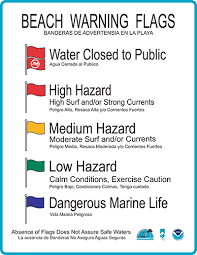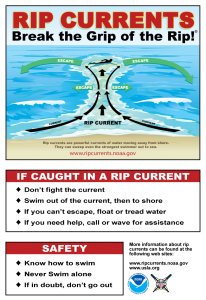With summer quickly approaching beachgoers will be packing Florida’s beaches. Unfortunately, many beachgoers are unaware  of the presence of rip currents, and worse, how to survive if they are caught in one.
of the presence of rip currents, and worse, how to survive if they are caught in one.
A rip current is a narrow, fast-moving channel of water that starts near the beach and extends offshore through the line of breaking waves. Rip currents can occur at any beach with breaking waves.
The United States Lifesaving Association (USLA) estimates over 100 people in the United States are killed by rip currents each year. Rip currents account for over 80% of rescues performed by beach lifeguards.
If you get caught in a rip current, the best thing you can do is stay calm. It is not going to pull you underwater; it is just going to pull you away from shore.
The National Oceanic and Atmospheric Administration (NOAA) shares these tips on how to survive a rip current:
- Do NOT fight the current. It’s a natural treadmill that travels an average speed of 1-2 feet per second, but has been measured as fast as 8 feet per second—faster than an Olympic swimmer.
- Relax and float to conserve energy. Staying calm may save your life.
- Do NOT try to swim directly into the shore. Swim parallel to the shoreline until you escape the current’s pull. When free from the pull of the current, swim at an angle away from the current toward shore.
- If you feel you cannot reach shore, relax, face the shore, and call or wave for help. Remember: If in doubt, don’t go out!
When you first get to the beach, the best thing you can do is swim in a guarded area. If you have questions about whether the conditions are hazardous or not, ask a lifeguard. Also, many beaches have a flag system or other forms of communication to be able to tell you if the conditions are hazardous.
Be aware of the Rip to help make your trip to the beach a safe and enjoyable one.


